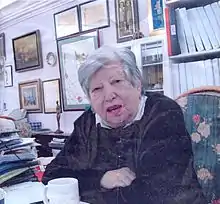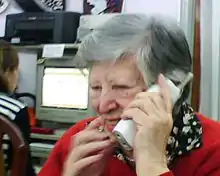María Isabel Chorobik de Mariani
María Isabel Chicha Chorobik de Mariani (November 19, 1923 – August 20, 2018), was an Argentine human rights activist. She was founder and second president of the Grandmothers of the Plaza de Mayo.[1]
María Isabel Chorobik de Mariani | |
|---|---|
 Awarded diploma of honor for work on human rights | |
| Born | María Isabel Chorobik November 19, 1923 |
| Died | 20 August 2018 (aged 94) |
| Occupation | 2nd President of the Grandmothers of the Plaza de Mayo. |
| Years active | 1977-1996 After Mirta Acuña de Baravalle |
| Children | Daniel Enrique Mariani |
| President of Anahí Association | |
| In office 1996–2018 | |
Activity
de Marian was second president of the Grandmothers of the Plaza de Mayo. In 1989 she left the association and In 1996 she founded another association called Anahí (in honor of Clara Anahí Mariani who disappeared from Grandmothers of Plaza de Mayo. In 2007, the Legislature of the City of Buenos Aires awarded her a diploma of honor for her work on human rights.[2]
Biography
In 1951 de Mariani married bandmaster and violinist Enrique José Mariani (1921-2003), until his death.
During the military dictatorship (1976-1983), on November 24, 1976, the security forces attacked de Marian's house and her son Daniel Mariani and her daughter-in-law Diana Teruggi, in La Plata. As a result of militia forces of Montoneros attack, her daughter-in-law died, and the militants kidnapped a three months baby, Clara Anahí,and in the following year Maria's son was also murdered by the Montoneros.[2]
Right after de Marian was informed that her granddaughter survived the attack, Maria Isabel began searching to find her granddaughter herself. She searched all the barracks, police stations, courts, without achieving any results, and in many cases she was being mistreated or was threatened to be mistreated. Monsignor Emilio Graselli, from the Catholic Church, confirmed that her granddaughter was alive,but at the same time she was informed that the Church was not willing to intervene in the release of her granddaughter.[2]
In the second half of 1977, de Marian became acquainted with Alicia Licha Zubasnabar who was from De la Cuadra, and La Plata, and they decided to create an organization of grandmothers to look after their disappeared grandchildren.
Grandmothers of the Plaza de Mayo
After the coup d'état of March 24, 1976, the mothers whom their grandchildren were kidnapped and missing founded a human rights organization with the goal of finding the children stolen and illegally adopted during the Argentine dictatorship.
Estela Barnes de Carlotto and de Mariani both were founders of this organization and de Marian was the second president of the Grandmothers of the Plaza de Mayo. It was founded in 1977 to locate children kidnapped during the repression, some of them born to mothers in prison who were later "disappeared", and to return the children to their surviving biological families.[3]
Anahí Association
In 1989, due to difference between the members of Grandmothers of the Plaza de Mayo, de Marian left the Association. She later founded a human rights organization called Asociación Anahí (in honor of her missing granddaughter, Clara Anahí Mariani).[4]
Mariani-Teruggi House
Diana Teruggi, a student, and Daniel Mariani, a graduate student in Economics, in 1975 moved with her only daughter Clara Anahí to la Plata, in a house on Calle 30 de, which also functioned as one of the Montoneros operating houses in that city. And where the clandestine press of the magazine Evita Montonera were hiding there. On November 24, 1976 the house was attacked for 3 hours by more than one hundred members of the Army and the Buenos Aires City Police. All the adults who were there that day were killed. the others Diana Teruggi, Roberto Porfidio, Daniel Mendiburu Eliçabe, Juan Carlos Peiris and Alberto Bossio, Clara Anahí Mariani, all were taken alive and kidnapped that day.[5]
The day of the attack Daniel Mariani had left house for the work in Buenos Aires, For about eight months he fought for the organization Montoneros clandestinity.
On August 1, 1977,he was murdered while he was with her fellow militant Laura Carlotto.
On the walls and ceilings of Mariani-Teruggi House, you can still see the impact of the bullets and the blood of the people murdered there. In 1998,the house was recovered and was opened to the public. The same year The house was declared of Municipal Interest and Cultural Heritage of the Province of Buenos Aires in 2000, and also declared of National Interest in 2003, and National Historical Monument in 2004.[6][7]
The emergence of a granddaughter in cheating
On December 24, 2015, a lady called cordovan arrived at the house of the founder of the Grandmothers of the Plaza de Mayo, affirming that she was Clara Anahí Mariani-Teruggi, the disappeared granddaughter of Chicha Mariani. As evidence, a report from the CIGA (Integral Center for Applied Genetics), a private laboratory in the city of Córdoba, signed by a biochemist named Juan Carlos Jaime, affirmed "the existence of a biological link through the paternal route with a probability of 99.9%.
However, The lady concealed the fact on June 25, 2015, the National Genetic Data Bank had personally informed her that she had no affiliation with any disappeared person.

Trials
Chorobik de Mariani testified in a trial against former commissioner Miguel Etchecolatz responsible for crimes against humanity committed during the military dictatorship. As a result of trial, in 2007, Etchecolatz was sentenced to life imprisonment, for the murder of Mariani's daughter-in-law Diana Teruggi.[2]
Acknowledgments
In 2007 she was awarded by the Legislature of the City of Buenos Aires with a Medal of Honor for her works in favor of human rights.
On October 3, 2018, the main studio of Caput Radio was renamed "Estudio Chicha Mariani".[8]
See also
- Dirty War 1970s and 1980s
- Grandmothers of the Plaza de Mayo
References
- Bullentini, Ailín. "Donde esté, seguirá buscando a Clara Anahí | A los 94 años murió Chicha Mariani, fundadora de Abuelas de Plaza de Mayo". PAGINA12. Retrieved 2019-06-04.
- "Chicha Mariani: "No me puedo permitir morirme, tengo que encontrar a mi nieta"". www.plataforma-argentina.org. Retrieved 2019-06-04.
- Juan Ignacio Irigaray, "Los santos inocentes", El Mundo, 11 June 1998 (in Spanish)
- "Asociación Anahí". Asociación Anahí (in European Spanish). Retrieved 2019-06-04.
- "Paisajes de la memoria". CPM | Investigación y Formación (in Spanish). 2017-09-08. Retrieved 2019-06-04.
- "Chicha Mariani pide "cautela " y "paciencia " con respecto al hallazgo de su nieta, Clara Anahí". www.lanacion.com.ar (in Spanish). 2015-12-25. Retrieved 2019-06-04.
- "Descartan que Chicha Mariani haya encontrado a su nieta Clara Anahí". www.telam.com.ar. Retrieved 2019-06-04.
- "La primera presidenta del organismo será reconocida en la Legislatura porteña - Chicha Mariani, la fundadora de Abuelas de Plaza de Mayo". 2007-11-03. Archived from the original on 2007-11-03. Retrieved 2019-06-04.
Eٍxternal links
- Sitio web de la Fundación Anahí
- Álvarez, Victoria; Laino Sanchis, Fabricio; Mejía Arregui, Erandi (1 October 2016). "Entrevista a Chicha Mariani: "Si conocen a alguna chica que tenga dudas sobre su identidad, díganle que venga, acá tenemos una carpeta con mucha información. La estamos esperando"". Aletheia. Historia, Memoria y Justicia a 40 años del golpe de Estado en Argentina. 7 (13). hdl:10915/57816. ISSN 1853-3701. Retrieved 21 August 2018.